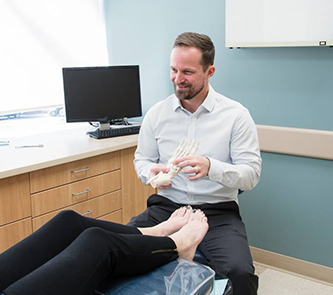Understanding Foot and Ankle Fractures
You might not be aware of this:
Over 25% of all the bones in your body are contained in your feet and ankles!
Now, if you think about how small your feet are in relationship to the rest of your body, that may seem rather odd. It does make more sense, however, when you take a moment to consider that your lower limbs need to be intricately structured just to keep you upright, mobile, and able to perform all kinds of physical activities.
In spite of their relatively small stature, these bones can cause big pain when they’re fractured—and that’s a major symptom of this fairly common injury.
Whereas broken bones might not be as frequent as conditions like heel pain or ingrown toenails, many people do sustain foot and ankle fractures.
The bones in our bodies are strong and able to endure tremendous amounts of physical force. As a prime example of this, your foot and ankle bones endure force loads that can reach as much as twice your total bodyweight on the landing foot every time you take a step. (And if you run, that number can rise to as much as four times your weight!)
Even though bone tissue is relatively strong, it’s not infallible!
Severe physical force from blunt trauma or an accumulation of stress over time—such as the case with excessive exercise—can lead to fissures, cracks, and broken bones.

Not all breaks are equal!
There are a variety of different types of bone fractures, including:
- Simple fractures. Also known as closed fractures, the only damage in this type of break is sustained by the bone, and not any of the surrounding tissues (including skin).
- Compound fractures. Whereas simple fractures do not damage other tissues, the skin is punctured in this kind of break. The puncture can be caused by either the bone itself or the physical trauma responsible for breakage in the first place.
- Stable fractures. Often a “best case” break, the fractured ends of the affected bone remain lined up (as they normally would be oriented). The reason this is ideal—insofar as a broken bone can be—is because everything is in place to mend together in a proper manner.
- Displaced fractures. Unlike stable ones, these kinds of breaks are those wherein the bone is broken in such a way that its position has changed (from where it belongs).
- Comminuted fractures. If you have a bone that has broken into more than two fragments, this is the kind of break you’ve sustained. Due to the considerable amount of energy and force for this injury, a comminuted fracture is most likely to be caused by high-impact trauma (like auto accidents).
- Transverse fractures. In a transverse fracture, the break is perpendicular to the injured bone. These particular fractures usually go through the entire bone (thereby breaking it into two pieces).
- Oblique fractures. As opposed to a transverse fracture, an oblique one is angled or curved. These fractures are quite common, but they are more often seen in longer bones than the ones in our feet.
- Spiral fractures. These breaks can be formed by strong, twisting forces – particularly when the body is in motion while the foot is planted (which can also cause other issues, like turf toe). The fracture itself looks like a winding staircase or corkscrew. This particular pattern develops on account of a bone being longer than it is wide.
- Avulsion fractures. Tendons and ligaments are essential connective tissues—with tendons connecting bone to muscle and ligaments connecting bone to bone—but sometimes they can contribute to broken bones. Such is the case with an avulsion fracture. In this instance, a small piece of bone is torn off from the main bone – typically as the result of either overexertion or an accident.
- Stress fractures. These are tiny, hairline cracks that develop over time in the surface of a bone as a result of excessive cumulative forces. This can be thought of as being an “overuse” kind of injury.
Mending broken bones
When it comes to treating a foot or ankle fracture, your body will do most of the “heavy lifting.” As it does, broken bone tissue is repaired in three stages:
- Inflammation –This stage is initiated almost immediately after the fracture occurs and is necessary, ensuring the injured area receives the blood it needs. Clotting blood then provides a bit of stability and the initial framework for your body as it produces new bone tissue.
- Bone production –In the second stage of healing, clotted blood is replaced by cartilage and other fibrous tissues (which will eventually be replaced themselves by solid bone tissue).
- Bone remodeling –By the time your body enters the third stage of healing, bone tissue is now developing. As it does, it becomes compact and dense. Whereas circulation had previously been elevated to provide extra blood to the area, it now reverts back to normal levels.
On account of potential differences across an array of factors, there is a fair amount of variance when it comes to how long it takes a broken bone to heal. In most cases, however, we are looking at roughly a six- to eight-week window for a fracture to heal to a significant degree. For children, the healing might be a little quicker, since adult bones tend to heal more slowly.

So how can we help?
Our role is to make sure broken bones are in proper position—and stay there—for optimal healing. Further, we can provide care to help manage symptoms you may experience until your foot or ankle bones have mended.
Taking all of that into consideration, care for some kinds of fractures (simple ones, in particular) is a matter of immobilizing the affected area. In doing so, we can prevent further damage and keep the bone in correct alignment while your body does its part. Options for keeping the affected bone(s) in place include buddy-taping, bracing, and casting
With regards to pain management for your broken foot or ankle, we will likely create a treatment plan consisting of conservative options. Your actual customized treatment takes an array of factors into consideration, but could very well include medication, icing, and some good old-fashioned rest.
Of course, not all fractures in feet and ankles are simple!
In the case of comminuted or displaced fractures, the odds are greater we will have to perform a surgical procedure. If this is something we are recommending, the intent is to put bone parts into a proper position and then secure them in place.
To keep bone parts where they need to be during the healing process, we may need to use a combination of pins, screws, and/or plates.
Don’t worry if surgery is required! For one thing, we are highly skilled and experienced in using surgical intervention to help patients overcome issues just like this. More than that, we will carefully discuss the procedure together so you know what to expect.
Your first step in recovering from a broken foot or ankle is to contact the professionals at Northeast Foot and Ankle. We will evaluate your situation, determine the extent of the injury, and then create a treatment plan so your broken bone heals correctly. Contact us today by calling (603) 431-6070 or schedule your appointment for either our Portsmouth or Nashua offices online!
Pay Your Bill
Make a payment online through our payment portal or Care Credit!
Portsmouth Office
14 Manchester Square, Suite 250
Portsmouth, NH 03801
Nashua Office
17 Riverside Street, Suite 205
Nashua, NH 03062
Website Hosted by SC Digital



